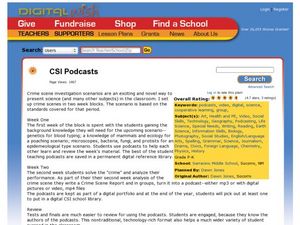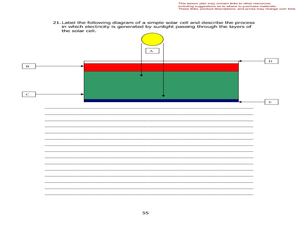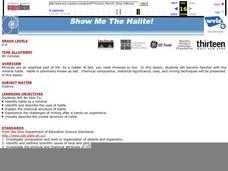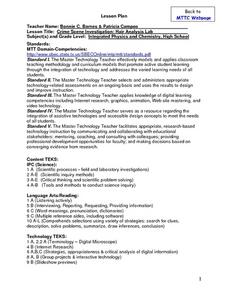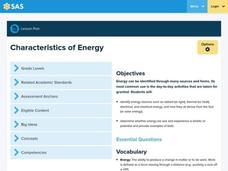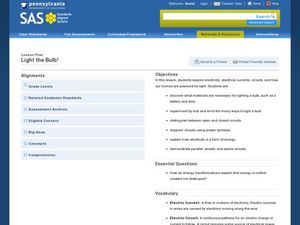Curated OER
The Science and Technology of Food
Students examine the guidelines the United States Department of Agriculture places on food. In groups, they create a list of the foods they consume and discuss the political and environmental implications of purchasing the food. They...
Curated OER
Daphina Science, The Method of Investigation
Students determine what causes a reaction in a species of Daphnia. In this ecology based lesson plan, students are in a hands on project to demonstrate a controlled experiment with data collections. Students use laboratory tools in this...
Curated OER
Theater Game: "The Good, the Bad, and the Bountiful"
Students play a game to demonstrate the detrimental effects of an algal bloom on the environment. In this microorganism lesson, students discuss microbes and algae. They dramatize the effects of an algal bloom using a role-playing game.
Curated OER
CSI Podcasts
Learners investigate crime scene scenarios to meet standards. In this crime scene scenario instructional activity, students gather background information during the first week. They investigate topics such as mammals, genetics, bacteria,...
Curated OER
Plant Pollination
Students investigate methods of pollination for various flowers. In this plant biology lesson plan, students learn the parts of a flower and form a hypothesis about the method of pollination for the flower. They determine the validity of...
Curated OER
Photovoltaics and Solar Energy
Students experiment with photovoltaic cells and determine the energy use of their appliances. In this renewable energy lesson plan, students calculate the energy emitted by a photovoltaic cell through an inquiry-based lab. They keep...
Curated OER
Plankton / Phytoplankton
Learners discuss the importance of plankton in the ocean ecosystem. For this biology lesson, students identify the different types plankton by observing them under the microscope. They explain how plankton population affect global climate.
Curated OER
Show Me the Halite!
Introduce middle school mineralologists to halite. The opening of the lesson involves a video and worksheet to which there are no links. However, you can replace the video with any informational clip that you can find online about halite...
Curated OER
Alfalfa Butterfly/Caterpillar Lifecycle Investigation
High schoolers collect and record data. They model specimens. Students identify sex of butterflies. They analyze data. High schoolers make conclusions based on collected data. They compare and contrast the different groups of insects...
Curated OER
Crime Scene Investigation: Hair Analysis Lab
Students participate in a hair analysis lab. Using a digital microscope, students compare and contrast hair samples. They determine if the hair samples are human or animal. After completing lab results sheets, students share their...
Curated OER
Scientific Notation
Middle schoolers explore the concept of expressing numbers in scientific notation. In this scientific notation lesson, students understand the importance of using scientific notation by finding real world examples where scientific...
Curated OER
Pond Water
Students explore a creek environment. They make observations, identify the living and nonliving factors in the environment and collect a plankton sample to take back to the classroom. In addition, they look at plankton under a microscope.
Curated OER
Where Are The Dinosaurs?
Young scholars study what happened to the dinosaurs and possible causes of extinction. In this investigative lesson plan students create dinosaur eggs.
Curated OER
Wetland Transects
Students lay out transect lines beside a local stream or river. There they record species of plants and insects living around the stream. By doing so, students explore how to use transect sampling techniques, use a variety of methods to...
Curated OER
Cells=Life!
Ninth graders share what they know about cells. In this biology instructional activity, 9th graders study different microscopic images of the cell. They draw one and explain to their partner why they chose that image.
Pennsylvania Department of Education
Animal Classes and Their Ecosystems
Students explore animal characteristics by participating in an environment identification activity. In this animal habitat lesson, students discuss a range of different wild life and the ecosystems that they are a part of. Students view...
Curated OER
Classification of Cerealites
Students create a dichotomous key. In this categorizing lesson, students create a dichotomous key for different types of cereal. Students classify the cereal into groups such as flakes and cereal with holes. Students discuss their...
Curated OER
Characteristics of Energy
Fourth graders view a video and create a KWL to identify energy sources. In this energy sources lesson, 4th graders explore the meaning of energy, kinetic energy, potential energy, thermal energy, radiant energy, and electrical energy....
Pennsylvania Department of Education
Light the Bulb!
Third graders investigate electrical circuits and how light bulbs are powered. In this electricity and power activity, 3rd graders study the vocabulary necessary which includes the different types of circuits, electrical currents, and...
Curated OER
Common Prefixes, Suffixes, and Roots
Sixth graders identify word parts, such as prefixes, suffixes, and root words by cutting and pasting. After a lecture/demo, 6th graders utilize worksheets imbedded in this plan to gain practice working with these parts of speech.
Curated OER
Wacky Water Critters
Students visit a local creek or stream. They collect water samples from the creek and observe and sort the "water critters" they find in the sample, observing smaller organisms under a microscope if necessary. They identify each organism...
Curated OER
Exploring Food with Senses
Students explore properties of fruits and vegetables using their five senses. In this sensory activity instructional activity, students study fruit and vegetables through a microscope, using their sense of touch as they are blindfolded,...
Curated OER
Diseases
Sixth graders create a type of notebook or journal using colored copy paper on which to take notes. They complete research on a certain disease and report on it and then design their own disease causing bacteria or virus. Finally, 6th...
Curated OER
It's a Small World After All! (Pond Microcosms)
Young scholars use microscopes to investigate the diversity of life that exists in pond water. They then conduct a controlled investigation to study the effect of a pollutant (rice) on a microcosm ecosystem.





